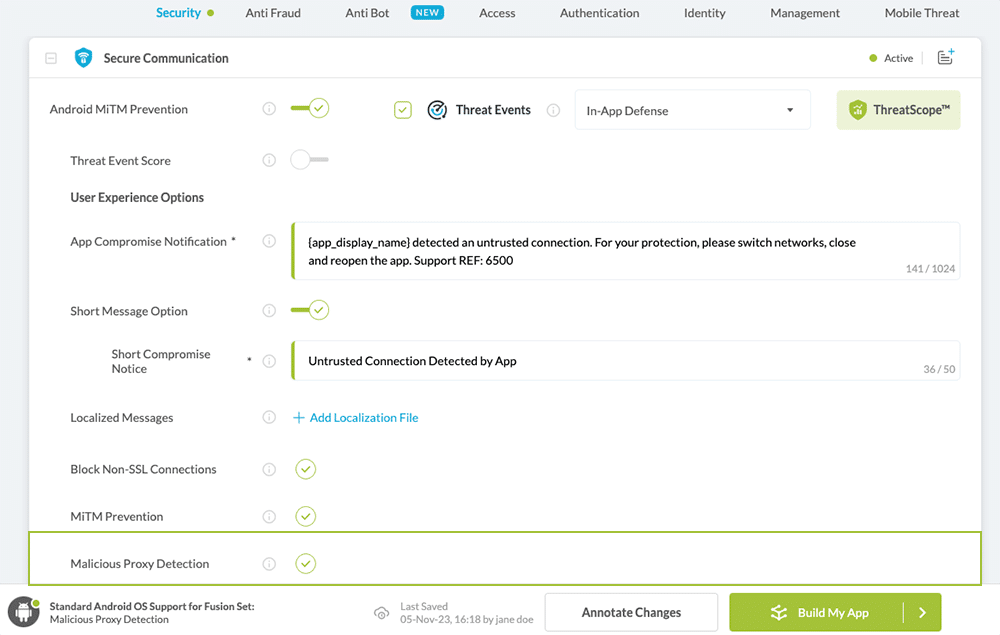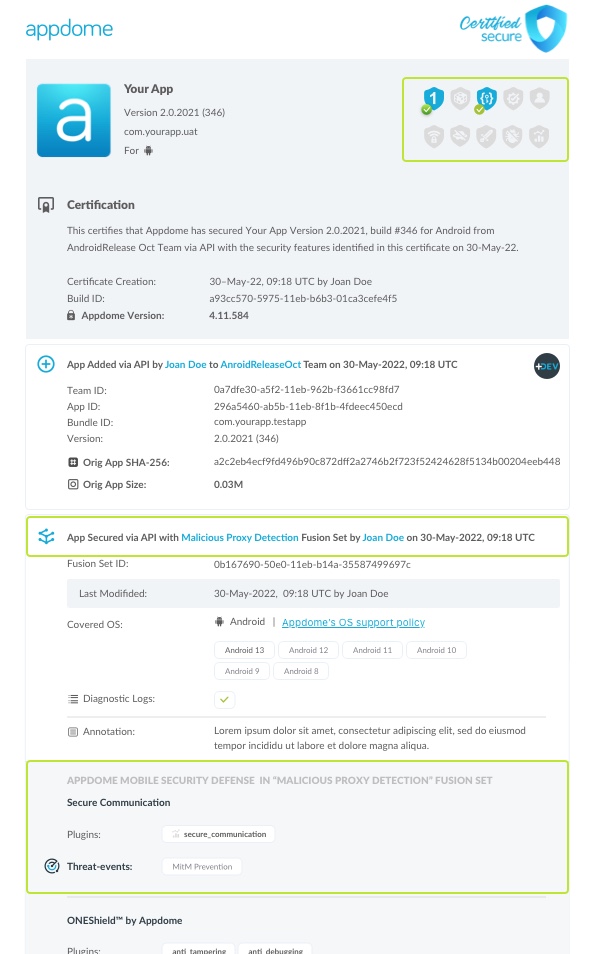How to Detect Malicious Proxies in Android & iOS Apps
Learn to Detect Malicious Proxy in Mobile apps, in mobile CI/CD with a Data-Driven DevSecOps™ build system.
What are Malicious Proxies?
Malicious proxies are proxy servers that are often used by malicious agents in mobile Man in the Middle (MiTM) attacks.
Hackers target insecure networks and Wi-Fi connections and hijack the connection between a mobile app and the server to which the app tries to connect. They then redirect the session to malicious proxies so they can perform malevolent actions such as harvesting data, stealing credentials, and depositing malware.
How Does Appdome Prevent the use of Malicious Proxy Servers?
When the Malicious Proxy Detection is enabled, Appdome detects any attempt to connect to or from unknown, untrusted, or malicious proxies or other intermediary devices.
Prerequisites for Using Malicious Proxy Detection:
To use Appdome’s mobile app security build system to Detect Malicious Proxy , you’ll need:
Appdome account (create a free Appdome account here)
A license for Pin to Host/MiTM Prevention
Mobile App (.ipa for iOS, or .apk or .aab for Android)
Signing Credentials (see Signing Secure Android apps and Signing Secure iOS apps)
Detect Malicious Proxy on Mobile apps using Appdome
On Appdome, follow these simple steps to create self-defending Mobile Apps that Detect Malicious Proxy without an SDK or gateway:
-
Upload the Mobile App to Appdome.
-
Upload an app to Appdome’s Mobile App Security Build System
-
Upload Method: Appdome Console or DEV-API
-
Mobile App Formats: .ipa for iOS, or .apk or .aab for Android
-
Malicious Proxy Detection Compatible With: Obj-C, C+, Java, JS, C#, C++, Swift, Kotlin, Flutter, React Native, Unity, Xamarin, and more
-
-
Build the feature: Malicious Proxy Detection.
-
Building Malicious Proxy Detection by using Appdome’s DEV-API:
-
Create and name the Fusion Set (security template) that will contain the Malicious Proxy Detection feature as shown below:
-
Follow the steps in Sections 2.2.1-2.2.2 of this article, Building the Malicious Proxy Detection feature via Appdome Console, to add the Malicious Proxy Detection feature to this Fusion Set.
-
Open the Fusion Set Detail Summary by clicking the “...” symbol on the far-right corner of the Fusion Set, as shown in Figure 1 above, and get the Fusion Set ID from the Fusion Set Detail Summary (as shown below):

Figure 2: Fusion Set Detail Summary
Note: Annotating the Fusion Set to identify the protection(s) selected is optional only (not mandatory). -
Follow the instructions below to use the Fusion Set ID inside any standard mobile DevOps or CI/CD toolkit like Bitrise, App Center, Jenkins, Travis, Team City, Cirlce CI or other system:
-
Build an API for the app – for instructions, see the tasks under Appdome API Reference Guide
-
Look for sample APIs in Appdome’s GitHub Repository
-

Figure 1: Fusion Set that will contain the Malicious Proxy Detection feature
Note: Naming the Fusion Set to correspond to the protection(s) selected is for illustration purposes only (not required). -
-
Building the Malicious Proxy Detection feature via Appdome Console
To build the Malicious Proxy Detection protection by using Appdome Console, follow the instructions below.
-
Where: Inside the Appdome Console, go to Build > Security Tab > Secure Communication section.
-
When you enable MiTM Prevention you'll notice that your Fusion Set you created in step 2.1.1 now bears the icon of the protection category that contains Malicious Proxy Detection

Figure 4: Fusion Set that displays the newly added Malicious Proxy Detection protection
-
Click Build My App at the bottom of the Build Workflow (shown in Figure 3).
-
Congratulations! The Malicious Proxy Detection protection is now added to the mobile app -
Using Appdome, there are no development or coding prerequisites to build secured Mobile Apps by using Malicious Proxy Detection. There is no SDK and no library to code or implement in the app and no gateway to deploy in your network. All protections are built into each app and the resulting app is self-defending and self-protecting.
Releasing and Publishing Mobile Apps with Malicious Proxy Detection
After successfully securing your app by using Appdome, there are several available options to complete your project, depending on your app lifecycle or workflow. These include:
- Customizing, Configuring & Branding Secure Mobile Apps
- Deploying/Publishing Secure mobile apps to Public or Private app stores
- Releasing Secured Android & iOS Apps built on Appdome.
Related Articles:
- Detecting Deep Proxy in Android Apps
- How to Prevent Session Hijacking Attacks, Prevent MitM Attacks in Android & iOS Apps
- How to Enforce SSL TLS Cipher Suites in Android & iOS Apps
- How to Prevent SSL Session Replay Attacks, Prevent MiTM Attacks in Android & iOS Apps
If you have any questions, please send them our way at support.appdome.com or via the chat window on the Appdome platform.
Thank you!
Thanks for visiting Appdome! Our mission is to secure every app on the planet by making mobile app security easy. We hope we’re living up to the mission with your project.


